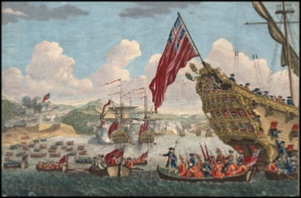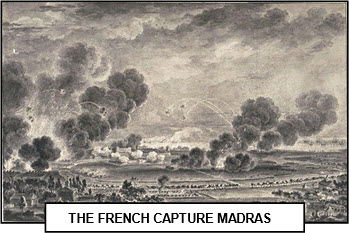


xxxxxThe King George's War in North America, starting in 1744, was simply an intensification of the border conflict which had been raging between the British, French and Spanish colonists for decades. In 1733 the British had strengthened the southern border of their territory by the establishment of Georgia, and this had kept the Spanish at bay in the south. In the north, however, fighting continued along the borders and further inland. Here the major event of the war was the British capture of the French fortress of Louisbourg, taken against all the odds in June 1745. Short of funds, an uneasy peace was finally reached by the Treaty of Aix-
KING GEORGE'S WAR, NORTH AMERICA
1744 -
Acknowledgements
Louisbourg: colour lithograph by the artist F. Stephen, 1747 – private collection. Madras: by the French marine artist Nicolas Ozanne (1728-
G2-
xxxxxIn North America, the so-

xxxxxDuring King George's War, begun in 1744, conflict intensified, especially along the frontiers of Acadia and New England, and the struggle for control of the interior, notably the Ohio Valley, also became fiercer. As in the past, many of these short, sharp battles proved inconclusive, but in June 1745 a force of 4,000 New England militiamen did manage to overrun Cape Breton Island (then called Isle Royale) and, with the aid of a British fleet, capture the French fortress of Louisbourg (illustrated). Commanding the entrance to the mouth of the St. Lawrence River, and regarded as impregnable, its capture was a morale boost of some importance. The French made two attempts to recapture the fort but without success.
 xxxxxIn the meantime, however, the British forces in India had no cause to rejoice. Here the French, under the command of their governor general Joseph François Dupleix, gained the upper-
xxxxxIn the meantime, however, the British forces in India had no cause to rejoice. Here the French, under the command of their governor general Joseph François Dupleix, gained the upper-
xxxxxIncidentally, the conflict which broke out in India in 1746 -
Including:
Colonial conflict
in India



